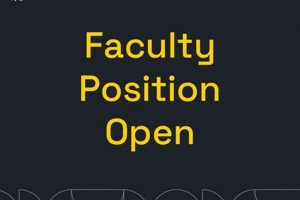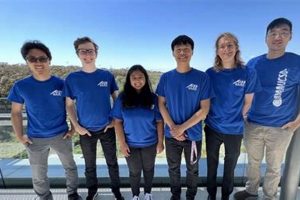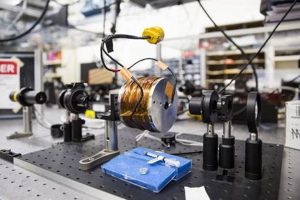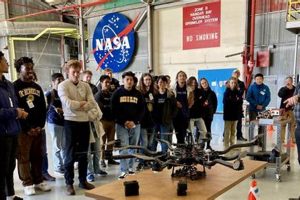Online platforms dedicated to specific professions foster community and knowledge sharing. A particular online forum, centered on the aerospace engineering field, facilitates discussions, resource exchange, and career-related advice among professionals, students, and enthusiasts. For example, users might share insights on computational fluid dynamics software, debate the merits of various propulsion systems, or seek guidance on navigating the job market.
These online communities offer several advantages. They provide a readily accessible source of information, connecting individuals with diverse experience levels and expertise. This access democratizes knowledge, allowing those in remote locations or without established professional networks to benefit from the collective wisdom of the group. Furthermore, these forums preserve institutional knowledge by documenting discussions and solutions to common challenges, creating a valuable archive for future generations of engineers.
This article will explore the topics most frequently discussed within these online aerospace engineering communities, examine the career advice offered, and analyze the potential for networking and professional development. Furthermore, it will assess the quality of information shared and provide guidance on effectively utilizing these online resources.
Tips from Online Aerospace Engineering Communities
Online aerospace engineering communities serve as valuable resources for professionals and students. The following tips, derived from recurring themes within these platforms, aim to provide practical guidance for navigating the field.
Tip 1: Cultivate a Strong Foundation in Fundamental Principles: Mastering core concepts such as fluid dynamics, thermodynamics, and structural mechanics is crucial. Regularly revisiting these foundational principles allows for a deeper understanding of complex aerospace systems and facilitates problem-solving. For example, a thorough grasp of Bernoulli’s principle is essential for understanding airfoil behavior.
Tip 2: Develop Proficiency in Relevant Software Tools: Familiarity with industry-standard software packages is highly valued. Tools like MATLAB, ANSYS, and SolidWorks are frequently used for simulation, analysis, and design. Investing time in learning these tools enhances productivity and employability. Practical application through personal projects or internships accelerates skill development.
Tip 3: Seek Out Mentorship Opportunities: Connecting with experienced professionals provides invaluable guidance and insights. Mentors can offer career advice, share industry knowledge, and provide feedback on technical work. Actively participating in professional organizations and networking events increases the likelihood of finding suitable mentors.
Tip 4: Emphasize Communication Skills: Aerospace engineering often involves collaborative projects and presentations. Developing strong written and verbal communication skills is essential for effectively conveying technical information to both technical and non-technical audiences. Practicing clear and concise communication improves teamwork and project outcomes.
Tip 5: Maintain a Growth Mindset and Embrace Continuous Learning: The aerospace industry is constantly evolving with new technologies and advancements. A commitment to continuous learning is essential for staying current and adapting to change. Regularly reading industry publications, attending conferences, and pursuing advanced education opportunities demonstrates a proactive approach to professional development.
Tip 6: Participate Actively in Open Source Projects: Contributing to open source aerospace-related projects can provide valuable practical experience and demonstrate a commitment to the field. These projects offer opportunities to collaborate with other engineers, learn new skills, and build a portfolio of work.
Tip 7: Network Strategically: Building a professional network is crucial for career advancement. Attending industry events, joining online communities, and connecting with professionals on platforms like LinkedIn can create valuable connections. Networking provides access to job opportunities, mentorship, and industry insights.
The aforementioned tips highlight the importance of a strong technical foundation, continuous learning, and effective communication within the aerospace engineering field. Integrating these practices can significantly enhance career prospects and contribute to professional growth.
The subsequent sections will delve into specific career paths within aerospace engineering and offer advice on navigating the job search process, leveraging the insights gained from online community discussions.
1. Community Engagement
Within online forums dedicated to aerospace engineering, community engagement manifests as active participation in discussions, the sharing of relevant resources, and collaborative problem-solving. These platforms provide a space for professionals, students, and enthusiasts to connect, fostering a sense of shared identity and purpose. A significant effect of this engagement is the accelerated dissemination of knowledge and best practices within the field. For example, an aerospace engineer might share a detailed explanation of a complex aerodynamic phenomenon, inviting feedback and further clarification from other community members. This process allows for the refinement of understanding and the identification of potential solutions to practical engineering challenges.
The importance of community engagement stems from its ability to overcome geographical barriers and promote continuous learning. Junior engineers often benefit from the experience of senior professionals, receiving guidance on design methodologies, simulation techniques, and career progression. Conversely, experienced engineers can gain insights into emerging technologies and novel approaches from younger members of the community. This reciprocal exchange of knowledge ensures that the community remains at the forefront of aerospace innovation. For instance, a discussion on the application of additive manufacturing in rocket engine development could bring together engineers with expertise in materials science, propulsion systems, and manufacturing processes, leading to a more comprehensive understanding of the technology’s potential.
In summary, community engagement is a critical component of the online aerospace engineering landscape. It fosters a collaborative environment where knowledge is shared, challenges are addressed, and professional networks are strengthened. By actively participating in these online communities, individuals can contribute to the advancement of the field and enhance their own professional development. The effectiveness of this engagement hinges on the willingness of members to contribute their expertise, ask questions, and engage in constructive dialogue, ensuring that the platform remains a valuable resource for the aerospace engineering community.
2. Knowledge Sharing
Knowledge sharing within online platforms dedicated to aerospace engineering, such as Reddit, constitutes a critical element of professional development and technological advancement. These platforms serve as dynamic repositories of information, experience, and collective problem-solving capabilities.
- Dissemination of Technical Information
Aerospace engineers utilize online communities to disseminate technical information concerning aerodynamics, propulsion systems, materials science, and other relevant domains. This includes sharing research findings, presenting simulation results, and offering insights into the design and analysis of aerospace vehicles. For instance, a discussion might center on the optimal airfoil design for a specific flight regime, with participants contributing experimental data, computational models, and practical considerations. This collective effort enhances the accessibility and understanding of complex technical topics.
- Troubleshooting and Problem-Solving
These forums function as collaborative troubleshooting environments. Engineers often post technical challenges encountered during design, manufacturing, or testing phases, soliciting advice and solutions from the community. A specific example could involve diagnosing anomalies in flight control systems or addressing structural integrity issues in composite materials. Community members contribute their expertise, drawing from past experiences and offering potential remedies. This collaborative approach accelerates the problem-solving process and reduces the likelihood of costly errors.
- Sharing of Best Practices and Lessons Learned
Experienced aerospace engineers often share best practices and lessons learned from previous projects. This may encompass guidelines for project management, recommendations for software selection, or insights into risk mitigation strategies. For example, an engineer might detail the process of implementing a new quality control procedure, highlighting both its benefits and potential challenges. By sharing these insights, the community avoids repeating past mistakes and promotes the adoption of more effective engineering practices.
- Accessibility to Open-Source Resources and Tools
Online platforms facilitate the sharing of open-source software, tools, and resources relevant to aerospace engineering. This includes code libraries for data analysis, simulation software for aerodynamic modeling, and databases of material properties. By providing access to these resources, the community lowers the barrier to entry for aspiring engineers and promotes innovation in research and development. Moreover, it enables collaborative development and improvement of these tools, ensuring their continued relevance and effectiveness.
The multifaceted nature of knowledge sharing within these communities underscores their significance for the aerospace engineering profession. It promotes continuous learning, accelerates problem-solving, and fosters a collaborative environment that benefits both individual engineers and the industry as a whole.
3. Career Advice
Online forums dedicated to aerospace engineering, such as those found on Reddit, have become significant resources for career advice. This stems from the diverse user base, which includes students, recent graduates, and experienced professionals. A primary driver is the desire for realistic expectations about job roles, responsibilities, and potential career paths within the field. For instance, a student contemplating a specialization in propulsion might seek insights from engineers already working on rocket engine design to understand the day-to-day challenges and required skillset. The accessibility of these platforms allows for direct interaction with individuals in various aerospace sub-disciplines, offering nuanced perspectives not typically available through formal educational channels.
The career advice dispensed often revolves around practical aspects such as resume building, interview preparation, and salary negotiation. Senior engineers frequently share their own experiences, providing guidance on how to highlight relevant skills and navigate the complexities of the hiring process. Furthermore, specific advice related to certain companies or government agencies is commonly exchanged, including insights into work culture, management styles, and opportunities for advancement. This information can be crucial for individuals seeking to make informed decisions about their career trajectory. A recent graduate applying to SpaceX, for example, might seek advice on the company’s interview process or the types of projects they could expect to be involved in.
The importance of this online career guidance lies in its ability to supplement traditional career resources and provide a more candid and personalized experience. However, it’s crucial to critically evaluate the advice received, considering the source’s experience and potential biases. While online forums offer a valuable platform for career exploration, they should be used in conjunction with formal mentorship and professional development opportunities to ensure a well-rounded understanding of the aerospace engineering profession. Ultimately, the effective utilization of these resources can contribute significantly to navigating the complexities of an aerospace engineering career.
4. Software Discussion
The aerospace engineering domain relies heavily on specialized software for design, analysis, and simulation. Within the online community, robust discussions regarding these tools are prevalent, reflecting their critical role in the profession.
- Computational Fluid Dynamics (CFD) Software
CFD software, such as ANSYS Fluent or OpenFOAM, is frequently discussed in relation to its application in simulating airflow around aircraft, analyzing heat transfer in rocket engines, and optimizing aerodynamic performance. Discussions often involve comparing the accuracy and computational cost of different methods, troubleshooting convergence issues, and sharing tips for effective mesh generation. The complexity and computational demands of CFD necessitate collaborative problem-solving and knowledge sharing, making these online forums invaluable resources.
- Finite Element Analysis (FEA) Software
FEA software, including ABAQUS and NASTRAN, is essential for structural analysis, stress testing, and failure prediction of aerospace components. Discussions often center on modeling techniques, material property definition, and the interpretation of simulation results. Engineers exchange insights on best practices for ensuring the accuracy and reliability of FEA simulations, particularly in the context of safety-critical aerospace applications. Verification and validation strategies are commonly debated, reflecting the stringent requirements of the industry.
- CAD/CAM Software
Computer-Aided Design (CAD) and Computer-Aided Manufacturing (CAM) software, like CATIA and SolidWorks, are fundamental to the design and manufacturing processes in aerospace. Discussions focus on creating complex 3D models of aircraft and spacecraft components, generating manufacturing toolpaths, and integrating design and manufacturing workflows. Participants frequently share tips on parametric modeling, surface design, and the efficient use of CAD/CAM software for streamlining the product development cycle. Interoperability issues between different software packages are also common topics of discussion.
- MATLAB and Scripting Languages
MATLAB and other scripting languages, such as Python, are widely used for data analysis, algorithm development, and automation tasks in aerospace engineering. Discussions involve sharing code snippets, developing custom analysis tools, and implementing control systems algorithms. Engineers exchange knowledge on leveraging these tools for tasks ranging from flight data analysis to trajectory optimization, highlighting their versatility and importance in the aerospace workflow.
These software-centric discussions are a vital component of the online aerospace engineering community. They facilitate continuous learning, collaborative problem-solving, and the dissemination of best practices, ultimately contributing to the advancement of the aerospace industry.
5. Project Collaboration
Project collaboration, as a component of online aerospace engineering communities, represents a practical consequence of readily available expertise and shared interest. The existence of platforms like Reddit dedicated to the field facilitates the formation of ad-hoc teams focused on specific projects, ranging from theoretical problem-solving to the development of tangible prototypes. A cause of this collaborative impulse is the often-specialized nature of aerospace engineering, where individual engineers may possess deep knowledge in niche areas but lack the breadth necessary for comprehensive project execution. This necessitates the pooling of diverse skills and perspectives, a need efficiently addressed by these online communities. For instance, a project involving the design of a small-scale wind tunnel might draw participation from individuals specializing in aerodynamics, structural analysis, and instrumentation, each contributing their expertise remotely.
The significance of project collaboration within these online spaces lies in its ability to democratize access to complex engineering endeavors. Individuals who may not have the resources or infrastructure to pursue projects independently can leverage the shared resources and collective knowledge of the community. A practical example includes open-source projects aimed at developing flight control software or designing unmanned aerial vehicles (UAVs). These initiatives benefit from the contributions of numerous individuals, leading to faster development cycles and more robust solutions. Furthermore, these collaborations often serve as valuable learning experiences, allowing participants to enhance their technical skills and expand their professional networks. The documentation and shared code repositories associated with these projects also contribute to the broader aerospace engineering knowledge base.
In summary, project collaboration within online aerospace engineering communities is a direct result of the field’s complexity and the desire for shared innovation. This collaborative dynamic enables the pursuit of ambitious projects, facilitates knowledge transfer, and fosters a sense of community among aerospace professionals and enthusiasts. While challenges such as coordination across time zones and managing diverse skill sets exist, the benefits of project collaboration within these online environments far outweigh the drawbacks, contributing significantly to the advancement of aerospace engineering knowledge and practice.
6. Industry Trends
The aerospace industry is characterized by continuous technological evolution, economic fluctuations, and shifting geopolitical dynamics. Online forums frequented by aerospace engineers provide a real-time pulse on these trends, facilitating discussion, analysis, and adaptation within the profession.
- Sustainable Aviation
The pursuit of sustainable aviation practices is gaining momentum, driven by environmental concerns and regulatory pressures. Online discussions focus on electric propulsion, alternative fuels (e.g., sustainable aviation fuel, hydrogen), and lightweight materials. For instance, engineers debate the feasibility of electric aircraft for regional transport or share research findings on the emissions reduction potential of various biofuel blends. Awareness and proactive engagement with these trends are crucial for career relevance.
- Space Commercialization
The increasing commercialization of space activities, including satellite launches, space tourism, and resource extraction, is reshaping the aerospace landscape. Online forums reflect this shift, with discussions on reusable launch vehicles, satellite constellations, and the economic viability of space-based industries. Engineers share insights on the technical challenges associated with these ventures and analyze the market opportunities they present. This trend demands an understanding of business principles alongside traditional engineering expertise.
- Digitalization and Automation
Digitalization and automation are transforming aerospace engineering processes, from design and manufacturing to flight operations and maintenance. Discussions center on the implementation of digital twins, artificial intelligence (AI), and robotics in various aerospace applications. Examples include using AI for predictive maintenance of aircraft engines or employing robotic systems for composite material layup. Adaptation to these technologies requires proficiency in data analytics, machine learning, and automation programming.
- Advanced Materials and Manufacturing
The development and application of advanced materials and manufacturing techniques are critical for improving the performance, efficiency, and sustainability of aerospace systems. Online communities discuss the properties and applications of carbon fiber composites, titanium alloys, and additive manufacturing technologies. Engineers share experiences with new materials and manufacturing processes, analyze their cost-effectiveness, and evaluate their potential for enhancing aircraft and spacecraft designs. Staying abreast of these advancements is essential for maintaining a competitive edge in the industry.
These facets represent key industry trends that are actively discussed and analyzed within online aerospace engineering communities. The ability to engage with these discussions, share knowledge, and adapt to emerging technologies is paramount for success in the evolving aerospace landscape.
Frequently Asked Questions
This section addresses common inquiries and clarifies misunderstandings regarding the online presence and activities of aerospace engineers, particularly within the Reddit platform.
Question 1: What is the primary purpose of aerospace engineering communities on Reddit?
The primary purpose is multifaceted, encompassing knowledge sharing, career advice, and community building among professionals, students, and enthusiasts. These platforms facilitate discussions on technical topics, provide guidance on career paths, and foster a sense of belonging within the aerospace engineering field.
Question 2: How reliable is the information shared within these Reddit communities?
The reliability of information varies. While many participants are experienced professionals, it is crucial to critically evaluate all information received. Cross-referencing information with reputable sources, consulting with mentors, and exercising professional judgment are recommended practices.
Question 3: What types of career advice are typically found within these online forums?
Career advice ranges from resume and interview preparation to salary negotiation and insights into specific companies or government agencies. Experienced engineers often share their experiences and provide guidance on navigating the job market, highlighting relevant skills and offering perspectives on work culture.
Question 4: Are there opportunities for project collaboration within these Reddit communities?
Yes. The collaborative nature of these platforms facilitates the formation of ad-hoc teams focused on specific projects. Individuals with diverse skills and expertise can contribute to open-source projects, prototype development, or theoretical problem-solving.
Question 5: What software packages are commonly discussed within these forums?
Discussions often revolve around industry-standard software packages such as ANSYS, ABAQUS, MATLAB, SolidWorks, and CATIA. Engineers share tips, troubleshoot problems, and discuss best practices for using these tools in design, analysis, and simulation.
Question 6: How can one effectively utilize these Reddit communities for professional development?
Active participation in discussions, asking questions, sharing expertise, and critically evaluating information are key. Networking with other professionals, contributing to open-source projects, and staying informed about industry trends can also enhance professional growth.
In conclusion, while online communities provide valuable resources and opportunities, critical thinking and professional judgment are essential for effectively leveraging these platforms.
The subsequent section will summarize the key benefits of engaging with “aerospace engineer reddit” communities and offer guidance on maximizing their potential.
Conclusion
This article explored the multifaceted role of “aerospace engineer reddit” as a valuable resource for professionals, students, and enthusiasts within the aerospace engineering field. The analysis encompassed community engagement, knowledge sharing, career advice, software discussions, project collaboration, and industry trend awareness. Each facet contributes to the collective understanding and advancement of the profession by democratizing access to information, fostering collaborative problem-solving, and providing a platform for candid discussions.
The continued utilization of such platforms necessitates a critical approach to information consumption and a commitment to responsible knowledge sharing. The collective effort to maintain the integrity and relevance of these communities directly impacts the future of aerospace engineering. Continued participation, thoughtful contribution, and critical evaluation will ensure these resources remain a valuable asset to the profession.







